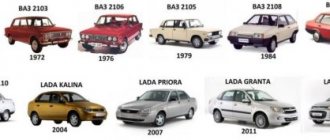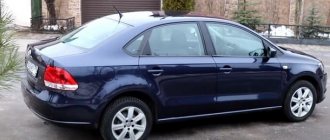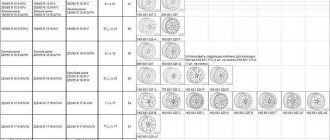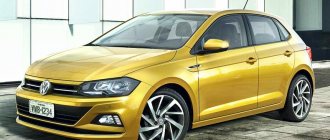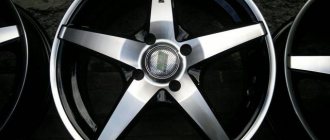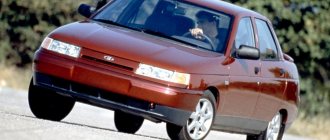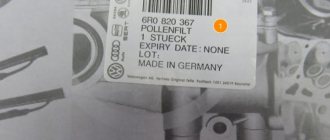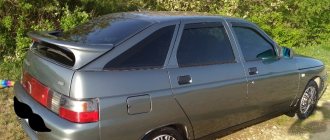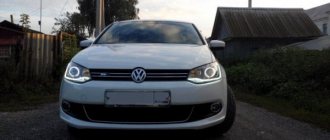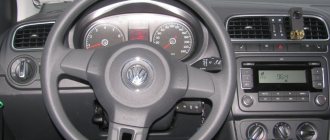After purchasing a car, the time comes when you need to change the rims on a Volkswagen Polo. In addition to the technical part of the issue, this is resorted to when there is a desire to update the car and make it more attractive on the road.
But it is worth noting that it is not always possible to correctly select the optimal disk sizes and their parameters. They will differ in standard and improved versions. If you don't choose the right one, problems can't be avoided.
Volkswagen Polo bolt pattern: about wheel bolt pattern on Volkswagen Polo sedan
If the original appearance of the car becomes boring, then in this case tuning comes to the rescue, which allows you to improve the car technically and visually.
It is possible to replace certain components with improved, sportier and more attractive ones.
The main element on which the appearance of a vehicle depends is the wheels. In this regard, car owners most often change them first. However, for any car, wheels are not only part of the design; Volkswagen T4 wheel bolt pattern is also an important technical component.
Road stability, handling and dynamic qualities depend on the characteristics and properties of tires and wheels, weight and many other properties. New wheels must comply with the original factory parameters and characteristics.
It is also necessary to choose the right tires, since incorrect sizes will have a bad effect on operation. The drilling parameter determines whether it is possible to install the selected Volkswagen T4 wheels with bolt pattern on the car.
If these parameters do not correspond, then the Volkswagen T4 disc bolt pattern should be special adapter rings, which entails mandatory intervention in the factory design. Volkswagen Polo rims: To explain it as simply as possible, the meaning of the indicator is the required number of bolts to attach the rim to the suspension and the diameter on which the mounting holes are located.
Wheel rim bolt pattern for Volkswagen
This information is important when choosing a new set of wheels. To avoid unnecessary problems, this data is unchanged for one specific model. On a note!
Knowing the value, you can choose from the discs available for sale that are of the highest quality and most suitable. Visually, it is almost impossible to correctly determine the diameter of a Volkswagen T4 disc bolt pattern depending on the number of fasteners. Free delivery is carried out in Moscow and the Moscow region, as well as to transport companies in other regions of Russia.
We will deliver the purchased wheels to the Volkswagen Transporter T4 2. When selling rims and tires to other regions of our country, we will deliver the goods in the shortest possible time.
Additionally, the pricing policy of our company is to provide the buyer with quality goods for minimal money. The price reduction is achieved by reducing additional overhead costs.
Lexus GS 5 x Lincoln Continental nuo m.
About the bolt pattern of rims on Volkswagen
Lotus Eclat 4 x Maserati 4 x Mazda iki m. MCC Smart 3 x Mitsubishi GT 5 x Nissan NX Volkswagen T4 wheel bolt pattern x Opel Ascona 4 x Peugeot 3 x - Peugeot 3 x - Peugeot 3 x Pontiac Trans Sport 5 x Porsche 5 x 25 Range Rover iki m. Renault 4, 5 3 x — Volkswagen T4 wheel bolt pattern 8, 20, 30 3 x — Renault 9, 11, 19 4 x Rolls Royce Silver Cloud 5 x Rover MGF 4 x Acclaim 4 x
Purpose and features
Milling or drilling is referred to as PCD - Pitch Circle Diameter.
In simple words, the name can be deciphered as follows: the required number of screws for attaching the rim to the suspension and the diameter on which the mounting holes are located. The meaning of perforation for Volkswagen Polo, as for other models, is individual. It is not possible to visually determine the bolt pattern on a Volkswagen Polo, unlike the number of fasteners. However, you can determine the value yourself using a ruler or caliper. The obtained values are entered into the appropriate formulas, the choice of which depends on the number of media on the disk.
VW wheel bolts
Basic disk dimensions: where to look and how to determine
Before we present information on the wheel bolt pattern inherent in cars of certain models, let’s understand their dimensions in general. After all, in order to purchase wheels, you need to know their exact parameters, or at least tell the seller the main characteristics of the car: year of manufacture, engine modification, and sometimes the body.
In the store they will select everything as it should be, but if you are going to buy wheels secondhand, you should know where the size is indicated on the rims. True, some parameters need to be measured independently.
Where is the width and diameter of the rim indicated on the disc?
Mounting bolts
The fit of the bolts used on standard discs is spherical. They should be of the following type:
- Bolt cap for fixing the wheel – 3СО 601 173.
- Wheel security bolts included M14X1.5x27.5, 1KO 698 137A.
- WHT 001 812 is available for a single bolt of this size.
The correct bolt pattern guarantees a high-quality and long-lasting ride without consequences. You should be careful here, especially when installing non-standard wheels.
Disc size indicators
There are five main sizes, an error in determining which will result in the impossibility of installing the wheel.
These include:
- number of bolt holes (LZ);
- the distance between them;
- diameter of the circle on which they are located (PCD);
- diameter of the central (hub) window (DIA);
- departure (ET).
The number of windows for bolts on passenger cars varies from 3 to 6. For trucks, this figure reaches 12-15 pieces. Togliatti-made cars have 4 bolt entries. The exception is the Lada Niva, the wheels of which are secured with five bolts each. The number of holes is measured visually by simple counting.
What is wheel rim bolt pattern?
The discs are fixed to the hub with special bolts or spokes. This depends on the size and weight of the disks themselves. For light alloy models, spokes are used reliably.
WATCH THE VIDEO
The bolt pattern is the size of the holes that are intended for fastening the discs with bolts, as well as their number.
As a rule, car enthusiasts, especially beginners, do not pay much attention to these parameters and think that the main thing is that the pins fit into the holes.
It should be taken into account that the bolt pattern of wheel rims is different for each car model. The abbreviation PCD is used to denote it.
If you choose the wrong product, this can result in a broken suspension, a loose steering mechanism, or, much worse, a wheel that can fall off while driving.
The parameters of wheel rims are absolutely the same for both cast and stamped products.
The labeling indicates:
- rim width is the first number. Indicated in inches. If there is a letter J next to it, this indicates that the wheels are suitable for single-wheel drive cars. All-wheel drive should look for the letter designation JJ;
- disc diameter (next number) – also measured in inches. The letter value H2 is more for specialists, it means that there are two protrusions on the rim;
- the numbers 4 by 98 are the wheel bolt pattern, where 4 is the number of bolts, and 98 is the size of the holes. These are the minimum values; they range from 4-6 and 98 – 139.7. It is almost impossible to determine these values “by eye”. Even if the difference is only 1-2 mm, it can cause the wheel to misalign.
- Disc offset – indicated in mm. Can be positive (ET30), negative (ET-40) or zero. It must necessarily comply with the manufacturer's recommendations, otherwise the disc may break under the influence of forces acting on the suspension;
- central hole (diameter) - indicated in mm. In passenger cars it can be from 50-70. If this value does not correspond to the dimensions of the landing cylinder, you can always get out of the situation - just purchase spacer wheels and adjust the elements.
Disc selection
There is a huge range of wheels on the market that can be easily installed on a Volkswagen Polo car. They can be made of steel or casting. The dimensions are also different, which will fully depend on the car model, year of manufacture and other parameters.
Much will depend on the manufacturers, who have a slightly different approach to the process of creating wheels for cars, which affects the quality and duration of the operating period. Among them, the most popular manufacturers are:
- K&K. Most often, original discs of high quality are offered. Presented in a classic silver color, size p15*J6 ET 40. Russian production is also pleasant in price. The cost of one disc is approximately 3,500 - 4,000 rubles.
- Alutec.
- Le Mans.
- Milan.
- Sakura.
This all applies to the creators of alloy wheels, which bring great attractiveness to vehicles. But as mentioned earlier, you should not experiment, especially if you own a car from a dealership that is covered by warranty. The manufacturer Wolf has the best quality. But here it offers consumers even a diameter of R17 with J7.5. The price will vary between 5,000 – 6,000 rubles, depending on the place of purchase.
Cheaper options on the market are brands for the Volkswagen Polo sedan such as Akula, M33, CR-06, Kyoto, the cost of which starts from 2,500 - 3,000 rubles.
There is a purchase option for installing conventional “stampings”, the cost of which ranges from 1,000 – 1,500 rubles. Article numbers AR075, 7280T, X40028 and other options are usually used. Much depends on the diameter of the stamped disc and its other parameters, which are shown in the photo.
Volkswagen Polo wheels: what do you need to know to choose them correctly?
A lot depends on the parameters of the wheels, from safety to comfort and optimal driving speed, taking into account the national climate and the condition of Russian roads. At the same time, we will try to consider in this review which 15-inch wheels for the Volkswagen Polo to choose or stick with 16, or even decide to leave 14-inch wheels on the German “people's car”.
Moreover, our review will be guided not only by the dependence of the car’s appearance on certain parameters and the type of wheels, but also take into account the durability of both tires and suspension.
There is no doubt that the most important components of the chassis of any car are the wheels, which must provide:
- Firstly, reliable grip of the car with the road.
- Secondly, a comfortable soft ride.
- And thirdly, controlled handling of the car even under the most unfavorable road conditions.
In order for all these requirements to be met, the wheel parameters must fully comply with the suspension characteristics of a particular car. At the same time, modern cars are equipped with two main types of disks, which can be either steel or light alloy. As for light alloy rollers, they, in turn, can be either cast or forged.
Steel wheels: features
Most budget cars, including budget versions of the Volkswagen Polo, leave factory assembly lines on steel “legs.” That is, they are equipped with steel disks, because they are made using the cheapest method of stamping from steel sheets, while connecting the plates and rims to each other by welding.
Among their disadvantages, experts believe: – high weight parameters compared to light-alloy wheel designs; – low resistance to corrosion;
– the presence of difficulties in the balancing process due to inaccuracies in adherence to manufacturing technology, which are inevitable when carrying out both stamping and welding work.
At the same time, steel wheel products are not without positive qualities: – low manufacturing cost; – quite high strength. Even if the impact load on the disks exceeds their strength characteristics, they are not destroyed, but only deformed. Which is of great importance for car safety;
– steel products are easily restored after deformation by rolling them, and cracks that appear in the metal can easily be welded.
Tires
Varieties
The tires on the Polo Sedan R15 are responsible for the comfortable movement of the car on the roads. Based on weather conditions, summer or winter tires are installed on the car, as well as all-season tires.
- Summer tires, unlike winter tires on a 15-diameter Volkswagen Polo sedan, are less noisy when driving and have a more straightforward tread pattern. They have excellent speed characteristics.
- What winter tires to put on a Volkswagen Polo sedan is decided by the owner of the German car himself. It all depends on the operating conditions of the vehicle. For driving on city streets at temperatures around zero degrees, European tires are suitable. The tread of such tires is distinguished by the presence of a large number of sipes necessary to drain slurry or water. They may have spikes for driving on slippery roads.
The Scandinavian type of winter tires for Volkswagen Polo sedan in sizes R15, R16, R17 is characterized by a soft compound, rubber material, and a large number of deep channels. The presence of pronounced zones, or spots as they are called, on the tread ensures reliable grip on the road surface. Such tires are used at low temperatures in northern regions with abundant snow cover.
Universal rubber is used year-round, but its use is limited by temperature: from -5 to +10 degrees.
In cold weather, the use of all-season tires on VW Polo is prohibited: the rubber hardens, which can lead to unpredictable situations on the road. In hot weather, it also loses its performance characteristics and wears out quickly.
Winter tires for Volkswagen Polo sedan
Tire sizes
The table shows what tire sizes for the Volkswagen Polo sedan should be installed on cars with different power units.
| Engine | Standard size | Speed index | Load Index | Pressure front/rear |
| 1395 cm3, 125 l. With. | 195/55R16 185/60R15 | T T | 85 84 | 1,8/2,0 1,8/2,0 |
| 1598 cm3, 90 l. With. | 185/60R15 175/70R14 | T T | 84 84 | 1,8/2,0 |
| 1598 cm3, 110 l. With. | 195/55R15 | T | 84 | 1,8/2,0 |
The T speed index means that this tire size for the VW Polo sedan can be used when driving up to 190 km/h. A coefficient of 85 and 84 shows that the tire can withstand a load of 515 and 500 kg, respectively.
In addition to the indicated values, there are also options for tire sizes, the use of which will not lead to disruption of the vehicle, for example, 195 by 65 for the Polo sedan.
Polo sedan on summer tires
Marking
Let's talk about tire markings for VW Polo. Let's take size 185/60R15 as an example:
- the first digit 185 indicates the profile width in mm;
- indicator 60 means the profile height of the tire as a percentage of the width;
- the letter R means the type of tire - radial, and not radius, as novice car enthusiasts think;
- The number 15 means the tire diameter in inches.
Manufacturers allow the installation of larger diameter tires during the summer season for tuning: R16, R17. It will help increase ground clearance and make the car's exterior more attractive. However, the standard tire size on the Volkswagen Polo sedan is 15 inches in diameter.
The cost of tires from little-known brands starts from 3 thousand rubles. Tires from famous manufacturers will cost the buyer 5-8 thousand rubles.
Tire markings for Polo sedan
What wheels are suitable for the Volkswagen Polo sedan, how to choose wheels and tires
The automaker installs three types of wheels on Volkswagen Polo sedan cars: 14" and 15" stamped wheels with a cap, as well as 15" alloy wheels.
Steel wheels come complete with decorative caps
Alloy wheels are included in the top-of-the-line Highline package. They come with tires in sizes 195/55 R15 and 185/60 R15. Steel wheels 6Jx15 ET38 are included in the Comfortline car kit and are mounted together with 185/60 R15 tires. Wheels from Highline are also suitable for this modification. The budget Polo Trendline series can only boast steel wheels with a diameter of 14 inches and 175/70 R14 wheels.
For cars manufactured before 2015, the following alloy wheels manufactured by VAG are suitable:
- 6RU6010258Z8–6Jx15H2 ET 40 Riverside, price - from 13,700 rub. and higher;
- 6R0601025BD8Z8 – 6Jx15H2 ET 40 Estrada, cost - from 13,650 rubles;
- 6R0601025AK8Z8 – 6Jx15H2 ET 40 Spokane, price - from 13,800 rubles;
- 6C0601025F88Z–6Jx15H2 ET 40 Novara, cost - from 11 thousand rubles.
The first code in the list is the catalog number. If the Polo sedan was released after 2015, you can add the following to the above disks:
- 6C06010258Z8–6Jx15H2 ET 40 Tosa, from 12,600 rubles and more;
- 6C0601025LFZZ–6Jx15H2 ET 40 5/100 Linas, minimum price - 12,500 rub.
For winter use, the automaker recommends 5Jx14 ET 35 wheels with 175/70 R14 tires.
Selection of non-original wheels
There are many discs from third-party manufacturers offered on the Russian market. For example, Russian-made 5Jx14 ET35 alloy wheels can be purchased at a price of 2,800 rubles per piece. Standard size 6Jx15 H2 ET 40, manufactured in Russia, will cost a little more, from 3300 rubles.
Those car owners who want to change the appearance of their car purchase alloy wheels with wider rims, up to 7 inches wide. The rim diameter can also be increased to 17 inches, but then you will have to select low-profile tires for it. The bolt pattern should remain the same - 5/100 or 5×100. The diameter of the center hole DIA should match the original (57.1 mm) or be slightly larger, but complete with installation rings that will help eliminate the difference in the diameter of the hub and the disc mounting hole.
It is better not to use an offset size of more than 40, although discs with a larger value are also suitable. The automaker recommends not doing this, since the load on the chassis will change and the car will also behave differently. With a larger offset, the tires will be positioned deeper and the wheel track will become smaller. There is a danger that when turning, the rubber will come into contact with the front fender liners. With a smaller offset, the tires will move outward. With such changes, you need to carefully select tire sizes.
Non-original wheels made in China are cheaper, but lose their appearance faster and are less durable
The choice of car tires on the market is huge. There are Russian and foreign-made skates that differ significantly in quality, mileage and cost. For safe driving, every Russian car owner must have two sets - summer and winter tires.
If you want to buy summer tires for 14- or 15-inch wheels that will fit the Volkswagen Polo sedan, you can choose from many offers. The price starts, on average, from 3 thousand rubles per piece. The more famous the manufacturer, the higher the cost. For example, prices for Bridgestone tires of various brands start at 4,500 rubles. Winter tires are sold in the same price range.
The price range of Michelin tires starts from 5,300 rubles
Video: how to choose wheels for a car
https://youtube.com/watch?v=dTVPAYWyfvg
Video: criteria for choosing summer tires for a car
https://youtube.com/watch?v=6lQufRWMN9g
Video: choosing winter tires for your car
https://youtube.com/watch?v=JDGAyfEh2go
Reviews from car owners about some brands of tires and wheels
see also
Comments 149
Tell me, will r17 and ET 52 fit? On the polo sedan
Dear Vladimir, read my comment more carefully, there is not a single word about the RUDDER. We are talking about the STEERING AXLE. Your quote from the text is that when ET changes, “in both cases the steering axis shifts,” so I wonder what kind of steering axis it is and where it shifts. Please clarify. Even more strange is your statement that a car does not have a steering wheel, and only ships and airplanes have one; it is strange how you drive your car without a steering wheel. Let’s not look into the etymology of the word “RUL”, let’s look at the dictionary, where the word RUL means a device for controlling the movement of a ship, airplane, car, tractor, etc. in a given direction (synonyms: steering wheel, steering wheel, steering wheel, etc.). By the way, the term helm, which has taken root on watercraft and aircraft, also means steering wheel, from the Dutch “stuur” - steering wheel and “wiel” - wheel. For reference, the first steering wheels on a car were lever-shaped in the form of a tiller, and then one craftsman installed a boat steering wheel on the car. Since then, the steering wheel has acquired the familiar shape of a wheel, and since we steer with this wheel, it is called a steering wheel. Regarding the wheel and disk, I understand that 99 out of 100 will say that it is a disk, but one will correctly say the wheel, and then another, etc. And you see, we will get rid of the slang imposed by illiterate traders who rushed to sell spare parts during the era of the collapse of the Union, and then disks (wheels), eggs (stabilizer strut), pig (industrial bearing support), TV (radiator frame), catalysts (catalytic converters) will probably disappear ) etc. By the way, you yourself accidentally started this fight when you wrote that 15 is the bore diameter, not RADIUS, but for many R15 means RADIUS. Quite recently, even sales consultants in car dealerships and auto shops plainly claimed that the R15 is a 15-radius wheel. I think that the correct terminology should be used not only in factories and technical departments. Vladimir You didn’t happen to study in the Murmansk region, my classmate is also Egorov Vladimir.
Dear author, you need to start by using the correct terminology accepted in the automotive industry. What you call a DISK is a WHEEL. In the automotive industry, a wheel is a structural element of a car located between the hub and the tire. Try typing GOSTS on the wheels and GOSTS on the wheels will pop up for you. I’m tired of repeating that wheels can be disc, discless, flanged, spoked, collapsible and non-dismountable, etc. If you call a discless wheel (used on heavy-duty vehicles) a disc, you will get a DISCLESS DISC or oiled wheel. The disc type of wheel, which is best known to the general consumer, consists of a DISC and a RIM. The disk is the part of the wheel with which the wheel is attached to the car hub, and the tire is mounted on the wheel rim. In the wheel markings, such parameters as PCD (bolt pattern according to you) and DIA (diameter of the central hole of the wheel disk) refer to the wheel disk, and 5j (width and shape of the side flange of the rim) and 15 (fitting diameter of the wheel rim in inches) refer to the rim wheels. ET offset, the distance between the plane of attachment of the wheel disk to the car hub and the central plane of rotation of the wheel rim, as can be seen in the ET wheel, the parameters of both the disk and the wheel rim are combined. I completely agree that ET is the most important parameter when choosing wheels and I don’t recommend playing with it when choosing a wheel. An example is the history of the domestic automobile industry: they produced classic VAZs on wheels with ET 29, and then front-wheel drive ones with wheels with ET40 appeared; all other parameters were suitable. Few people have heard about the offset and the owners began to install classic wheels on front-wheel drive, while the track increased by 22mm. This was enough to shift the load to the outer part of the bearing (by 11mm) of the wheel hub and a wave of complaints began. Having figured out the reason, the plant drew the attention of consumers that the wheels for these cars are not interchangeable. And this is not the most serious consequence of choosing the wrong wheel according to ET. But it’s difficult for me to understand how offset affects the displacement of the steering axle and, in general, what the author understands by this concept. And I also think that the size of 57.1 mm is the size of the central hole of the DIA wheel, but what the author means by hub diameter and which hub is not clear to me . I completely agree with the author’s main idea - when choosing wheels and tires, you must strictly follow the manufacturer’s recommendations and this will save you from many economic and legal troubles.
What is the wheel bolt pattern on a Volkswagen Polo sedan?
The Volkswagen Polo sedan version is equipped with rims with the following dimensions and parameters:
- R14/5.0J PCD 5×100 ET 35 DIA 57.1 - “Trendline” version;
- R15/6.0J PCD 5×100 ET 38 DIA 57.1 - maximum Highline configuration.
The drill size of the model is 5×100, the reach dimensions are from 35 to 38 millimeters, the diameter of the centering hole is 57.1 millimeters. When selecting products for a car, you must be guided only by these parameters; others simply will not work.
It is also important to take into account the width of the wheel rim, which in this case varies from 5.0 to 6.0. When choosing this larger size, you must take into account that the wheels may simply not fit in the arch. In addition, the offset parameter, designated ET, also varies, since it depends on the width of the rim. If this size is selected poorly, handling will be negatively affected and increased load will be placed on the suspension components.
Important!
All listed parameters and dimensions must be strictly observed. If some can be changed within certain limits, then it is undesirable to go beyond these limits.
Among the main features of the bolt pattern for the Polo model, one can highlight the prevalence of this parameter among European manufacturers. Related models from Skoda also received identical wheels. In this regard, there should be no problems with the selection of disks.
The bolt pattern of the latest generation Polo wheels is absolutely identical to the previous ones. To secure the wheels, five bolts are used, the mounting holes for which are located in a circle with a diameter of 100 millimeters. This means that wheels from an older modification can be installed on a new one, and vice versa. This makes life easier for car owners. For example, the wheel bolt pattern for Golf 4 is identical to Polo.
Fourth generation Golf
Standard wheels
In the standard version, the Volkswagen Polo sedan is equipped with “stampings” 5J-14, as well as 6J-15. In this case, 5 and 6 are the rim width, which is measured in inches on alloy wheels, J is the rim flange profile shape, and 14 and 15 are the rim diameter.
If you take a Polo in a Highline sedan body, it is marked with wheels 6J*15 ET 40 PCD 5*100. The correct location of the bolts is very important here, the distance between which must be maintained strictly at 100 mm. Disc offset (ET) is the distance to the plane of symmetry of the rim from its direct mounting. The unit of measurement used is millimeter. This is all provided for light alloy wheels.
The Volkswagen Polo is produced from the factory with an offset of 35 to 40 mm. In this case, the bolts are always located at a distance of 100 mm and are screwed in in the amount of 5 pieces.
The standard wheels will differ from each other in terms of bodywork. The parameters will be as follows:
- GF-6NAHW. All versions of the car produced in 2000 are equipped with wheels measuring 14*6.0 or 15*6.0. For this reason, the offset of the disk 43 and 45, respectively, will differ, which indicates the impossibility of using identical disks on different vehicles.
- ABA-9NBUD. If you take a car made in 1996, the wheels are 13*5.5 with an offset of 43. In 2007, 14*6.0 with a similar offset were installed on the car.
- GH-9NBBY. Wheel samples changed almost every year, as not only the size was adjusted from 14 to 16, but also the rim width from 6.0 to 6.5. But the offset and drilling remained unchanged.
- GH-9NBKY. In 2004-2007, the disks did not change and remained the same, namely 14 * 6.0. The only thing that is different is for the 2006 model. a rim diameter of 15 could be used, with all other identical parameters.
They use 5*100 drill bits almost everywhere. The only exception is the 2000 model GF-6NAHW body, which uses 4*100.
Engineers at the German car manufacturer do not rule out installing wheels with a diameter of R16 instead of standard ones. This is more focused on tuning and more on classic performance. But if the vehicle is purchased from a showroom, you can immediately forget about warranty service related to the chassis. That is, only the owner should decide this. This is called an experiment attempt, for which no one bears responsibility.
This is interesting: What kind of wheel bolt pattern is there in the field?
Generation 5 and 6
In the fall of 2003, the Volkswagen Golf V premiered in Frankfurt. The car was based on the latest platform, previously used for the Volkswagen Touran and Audi A3 II. The model also received a body with increased rigidity by 80% and a multi-link rear suspension. The dimensions of the car have become even larger. The rear passengers especially felt the increase, their legroom increased by 65 mm.
The design of the model consisted of 5 main elements, a clear silhouette of the side windows forming a single whole; belt line under the side windows; embossed sidewalls, a sweeping roofline and a specific C-pillar shape. Round twin headlights, pointed towards the center, appeared in front. Together with the radiator grille, they formed a V-shape.
The interior of the Volkswagen Golf V was made functional and extremely strict. All levels were clearly separated, and buttons and indicators were installed in their places. German designers improved most of the elements. The front seats have been completely updated.
Wheel sizes
The fifth generation again received a rich range of engines:
1. 1.4-liter gasoline engine (75 hp):
- 6J wheels on 15 ET47, tires – 195/65R15;
- 6J wheels on 16 ET47, tires – 195/60R16;
- 6.5J wheels on 17 ET50, tires – 195/55R17.
2. 1.6-liter gasoline engine (102 or 115 hp):
- 6J wheels on 15 ET47, tires – 195/65R15;
- 6.5J wheels on 16 ET47, tires – 205/60R15;
- 6.5J wheels on 16 ET50, tires – 205/55R16.
3. 1.8-liter turbo engine (180 hp):
- 7J wheels on 17 ET54, tires – 225/45R17;
- 7.5J wheels on 18 ET51, tires – 225/40R18;
- wheels 8J by 19, tires – 225/35R19.
4. 2-liter FSI (150 and 200 hp):
- 6.5J wheels for 16 ET50, tires – 205/55R16;
- 6.5J wheels on 17 ET50, tires – 205/50R17;
- wheels 7J on 18 ET47, tires – 205/45R18.
5. 1.9-liter and 2-liter turbodiesels (105 and 140 hp):
- 6J wheels on 15 ET47, tires – 195/65R15;
- 6.5J wheels for 16 ET50, tires – 205/55R16;
- 7J wheels on 16 ET47, tires – 225/50R16.
6. Version R32 with a 250-horsepower unit:
- 7.5J wheels on 18 ET51, tires – 225/40R18;
- 8.5J wheels on 19 ET45, tires – 255/30R19;
- wheels 9J on 20 ET42, tires – 265/25R20.
For this generation, the drilling parameters have changed:
- PCD (drilling) – 5 by 112.
Generation 6
The sixth generation of the Volkswagen Golf was presented in the summer of 2009. The appearance of the model has become as sporty as possible. At the front of the body, the elegant shape of the headlights, in line with the company's new philosophy, and the stylish radiator grille stood out. Due to the clearly defined line from the headlights to the rear lights, the body was visually stretched, making the car lower.
The interior of the Volkswagen Golf VI has a lot of decorative inserts and chrome applications. The new dashboard design features white backlighting. Already in the “base” the car was equipped with a climate control system “Climatic”.
The range of power units of the model has remained virtually unchanged. The sixth generation is based on a 1.6-liter unit (102 hp). The characteristics of the wheels (see 5th generation), characteristic of each modification, have also remained the same. At the same time, a new transmission appeared - a 7-speed DSG gearbox.
Overhang amount
Reach is no less important. Identified as DEPORT or OFFSET and expressed in mm.
There are three types of disc offset:
- Positive - the disk seems to be recessed into the middle of the wheel arch.
- Negative - most of the disk comes out, while the seat is “recessed” deep inside the disk itself.
- Zero – when both planes (imaginary and mating) coincide.
If a disk is purchased without matching the offset, it simply will not be possible to install it, since the suspension elements will not allow this.
How to choose the correct rim diameter for a VW Polo
To correctly select a particular model or replica wheel for your car, you need to find out the diameter and width of the disk, and then clarify where the mounting holes are located and in what quantity. Then you need to determine the offset indicator and the diameter of the Volkswagen hub, for which it is advisable to study the manufacturer’s catalog or measure everything yourself, using a special tool.
Note!
If a driver feels unsure about the responsible choice of cast, forged or stamped wheels for a vehicle, it is imperative to consult with an experienced specialist who will determine all the necessary parameters and dimensions.
As for the radius of the disk, it must be selected in full accordance with the recommendations of the machine manufacturer, and it must also coincide with the mounting diameter of the wheel. Today there are many extreme drivers who increase the mounting diameter by rolling the inch fit. For example, a 16-inch seat can be converted to fit an 18-inch wheel.
Special attention should be paid to the wheel offset, which is the distance between the longitudinal plane of the rim and the mounting plane of the disk. The wheel offset value can be negative, positive or zero.
Wheel offset values
It is advisable to approach the purchase of original wheel components for a vehicle with all responsibility, since any mistake can lead to accidents on the road. It is strictly forbidden to deviate from the standard values and parameters set by the manufacturer, because you can cause harm not only to the car, but also to your health.
1.9TDi 148hp
| Volkswagen Golf 2005 | 1.9TDi |
| Generation: | Mk4 [1997..2005] |
| Power: | 148 hp | 110 kW | 150 PS |
| Engine: | l4, Diesel |
| DIA: | 57.1mm |
| Thread: | M14 x 1.5 |
| Fastening type: | Bolt |
| Years of production: | [2000 .. 2005] |
| Tire | Disk | Tire pressure | Sverlovka |
| 195/65R15 91V | 6Jx15 ET38 | 2.1 / 1.9 30 / 28 | 5×112 |
| 205/60R15 91V | 6.5Jx15 ET35 | 2.1 / 1.9 30 / 28 | 5×112 |
| 205/55R16 91T | 5.5Jx16 ET36 | 2.1 / 1.9 30 / 28 | 5×112 |
| 205/55R16 91V | 6.5Jx16ET42 | 2.1 / 1.9 30 / 28 | 5×112 |
| 225/50R16 87H | 7.5Jx16 ET36 | 2.3 33 | 5×112 |
| 225/45ZR17 94W | 7Jx17 ET38 | 2.1 / 1.9 30 / 28 | 5×112 |
Is it possible to install wheels with an unsuitable bolt pattern?
Some motorists, in an attempt to save on the purchase of spare parts with the necessary parameters, purchase products that do not correspond to the car brand. Such wheels are subjected to self-processing, the hub hole is widened, the location of the bolts is changed, and then they are installed on the car.
Theoretically, such a modification is possible, but the work must be carried out with maximum precision. It is impossible to measure a disc so correctly in a garage. And inaccurately drilled cutouts lead to wheel runout, destruction of the hub and suspension elements, and disruption of vehicle stability on the road.
Competent modification of the car in conditions close to factory ones is not economically feasible. The work will cost more than purchasing a wheel that initially matches all sizes.
Parameters of original wheels for Volkswagen Polo
For Volkswagen Polo, the size of the central hole in the disk cannot be smaller. A minimal upward deviation is allowed. H HAMP - translated means protrusion or mound. Indicates the presence of ring protrusions necessary for fixing the beads of tubeless tires.
When there is one protrusion, this parameter is displayed as H. If there are two protrusions, which is necessary to install run-flat tires with reinforced sidewalls, then the marking should be H2. Tubeless tires can only be installed on wheels that have HAMP. It should be remembered that when the offset of the disk changes, the operation of all suspension components changes.
Therefore, you should not go beyond the limits recommended by the automaker. Knowing what the wheel markings mean, you can avoid making the wrong choice when buying wheels for your Volkswagen Polo.
Everything you need to know about tires A wheel tire is a complex and multifunctional product. Rubber must ensure: It is the slopes that determine the vehicle's maneuverability in poor road terrain, as well as fuel consumption and the nature of the noise produced when driving.
Modern tires differ in several parameters: Design features Today, radial tires prevail on the market; Volkswagen Polo sedan rims are almost never produced due to their outdated design and short service life.
The design of the Volkswagen Polo sedan wheel rim is determined by the arrangement of the cord material, which gives the rubber strength and flexibility. Cord is thin threads made of viscose, cardboard or cotton. Thin metal wire is also used to make them.
This material is becoming increasingly popular among manufacturers and motorists. The most modern technologies are used to produce tires. Below are the characteristics of the main components of radial tires: The frame is the main component that accepts loads from the outside and compensates for the air pressure in the cavity from the inside.
The quality of the frame determines the strength characteristics of the slope. It is a rubberized cord thread, which is laid in one or several layers. Breaker is a protective layer located between the frame and the tread layer.
Protects the entire structure from damage, adding strength to it, and also prevents delamination of the frame.
It consists of layers of metal cord wire, the space between which is filled with artificial rubber. The protector is a thick layer located on the outside. It is in contact with the road surface, transferring forces to it during acceleration and braking. Its Volkswagen Polo sedan wheel rim has the shape of a relief, covered with patterned grooves and protrusions. The shape and depth of this pattern determine the conditions in which summer, winter or all-season tires are best used.
The tread ends on both sides with mini-sidewalls or shoulder areas. Sidewall is that part of the tire that is located between the shoulder areas and the bead. They are usually marked. They consist of a frame and a relatively thin rubber layer that protects from external influences and moisture. The side zone is responsible for attaching to the wheel rim and sealing the internal space if the slope is tubeless.
In this rigid part, the frame cord is wrapped around a ring made of rubber-coated steel wire.
Volkswagen Polo wheels
The top of this ring is covered by a rubber filling cord, which provides an elastic transition from the hard ring to the soft rubber of the sidewall. As you can see, the design of modern tires is quite complex. It is this complexity, which is the result of many years of searching, trial and error, that provides a long service life of rubber - more than thousands of kilometers on a Volkswagen Polo sedan rim.
Tire marking European-made rubber is marked in accordance with a single standard. In addition to the dimensions, other equally important parameters are displayed on the sidewall. Along with the above characteristics, there may be details that specify the Volkswagen Polo sedan wheel rim Week and year of manufacture, in the form of a sequence of 4 digits.
The first two indicate the week, the rest indicate the year of release.
General background information
Ranges of possible values for tires and wheels of Volkswagen Polo 2008.
Tires
| Diameter | 14″–17″ |
| Width (mm) | 165–205 |
| Profile (%) | 40–70 |
| The smallest size | 165/70 R14 |
| The biggest size | 205/40 R17 |
Wheel disks
| Diameter | 14″–17″ |
| Width (inches) | 5–7 |
| Reach (mm) | 35–43 |
| Drills | 5×100 |
Expert advice
When choosing tires for a car, you must first follow the manufacturer's instructions. Ask yourself a few questions.
- On what roads will the car be primarily used?
- Do you need increased cross-country ability?
- How much of the route will be city roads and how much will be highways?
- Will the vehicle carry heavy loads?
The answers to these and similar questions will help determine which tire parameters you need to pay special attention to.
How to choose the right wheels for Volkswagen Polo 2008?
- Stamped (economical price category) - made from a sheet of iron by stamping on a press.
- Light alloy - manufactured by casting (more reliable than stamped ones).
- Forged (the highest quality and more expensive than the previous ones) - made from light alloys by stamping at high temperatures.
The choice depends on financial capabilities. However, it should be borne in mind that the quality of the road surface on which you have to drive every day must also be taken into account.
So, if it gets into a hole, a stamped disk will bend and will not cause harm to the tire, but a forged or cast one can cut it. There is a possibility that the cast disc may burst or crack.
It should also be noted that repairing “stamping” wheels is cheaper than repairing cast or forged wheels. But wheels with high-quality cast and forged disks kill the suspension less, because lighter and have more perfect geometry (better balanced).
The same wheels may or may not rub with tires on the same car - wheel alignment adjustment will help here.
Wheel bolt pattern Volkswagen Golf IV (1J1) 2003 1.4 16V (75 hp, gasoline)
- Razboltovka.ru
- PCD
- Volkswagen
- Golf IV (1J1)
- 1.4 16V (75 hp, gasoline)
- 2003
Find disk parameters for Volkswagen Golf IV (1J1) 2003, 1.4 16V (75 hp, gasoline).
Table of parameters and wheel bolt patterns for the Volkswagen Golf IV (1J1) 1.4 16V (75 hp, gasoline) model – 2003.
Disc drilling parameters are usually called bolt pattern:
- LZ (number of holes)
- PCD (hole center circle diameter)
- ET (disc offset)
- DIA (hole diameter)
Save just in case so as not to lose!
| Volkswagen Golf IV (1J1) 1.4 16V (75 hp, petrol) | 2003 | 6.0 | 14 | 5×100.0 | 38 | 57.1 | Factory |
| Volkswagen Golf IV (1J1) 1.4 16V (75 hp, petrol) | 6.0 | 15 | 5×100.0 | 38 | 57.1 | Acceptable | |
| Volkswagen Golf IV (1J1) 1.4 16V (75 hp, petrol) | 6.5 | 15 | 5×100.0 | 40 | 57.1 | Acceptable | |
| Volkswagen Golf IV (1J1) 1.4 16V (75 hp, petrol) | 6.5 | 16 | 5×100.0 | 42 | 57.1 | Acceptable | |
| Volkswagen Golf IV (1J1) 1.4 16V (75 hp, petrol) | 7.0 | 16 | 5×100.0 | 42 | 57.1 | Acceptable | |
| Volkswagen Golf IV (1J1) 1.4 16V (75 hp, petrol) | 7.0 | 17 | 5×100.0 | 40 | 57.1 | Acceptable | |
| Volkswagen Golf IV (1J1) 1.4 16V (75 hp, petrol) | 8.0 | 18 | 5×100.0 | 40 | 57.1 | Acceptable | |
| Volkswagen Golf IV (1J1) 1.4 16V (75 hp, petrol) | 7.5 | 18 | 5×100.0 | 40 | 57.1 | Acceptable | |
| Volkswagen Golf IV (1J1) 1.4 16V (75 hp, petrol) | 8.0 | 19 | 5×100.0 | 40 | 57.1 | Acceptable |
razboltovka.ru
Parameters for various other brand models
The Touareg wheel bolt pattern and other required rim dimensions are equal to the following data:
- The number of mounting holes and the diameter of their location circle is 5x130;
- The diameter of the car hub is 71.5 millimeters;
- Rim diameter - from 17 to 20 inches;
- Rim offset - from 55 to 60 millimeters;
- Recommended width is 7.5 to 9.0 inches.
The bolt pattern for the Tiguan and the recommended wheel sizes for it are as follows:
- The rim drilling is 5×112;
- Rim width - from 6.5 to 9.0 inches;
- Rim diameter - from 16 to 19 inches;
- Wheel offset - ET from 33 to 38 millimeters;
- The diameter of the central hole is 57.1 millimeters.
